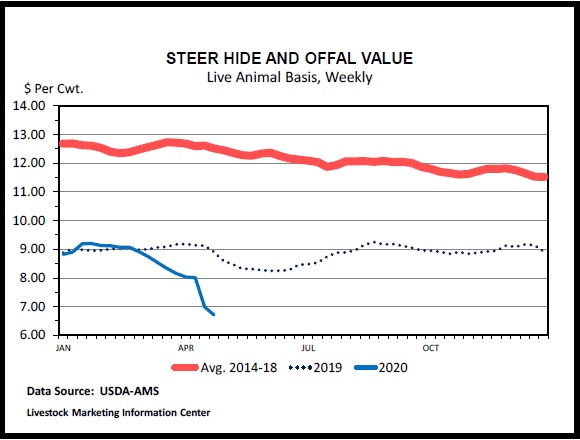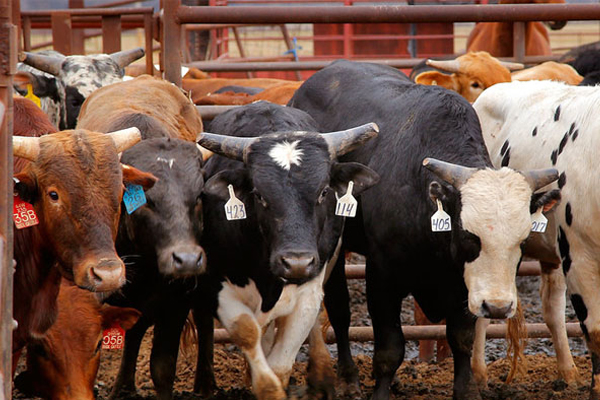May 5th
CONTACT: Stephen Sothmann, ssothmann@meatinstitute.org, 202/587-4250
U.S. Cattle Hide Value Declines Significantly in Wake of COVID-19
Hide now represents approximately 1% of a steer’s total value
The COVID-19 global pandemic has injected unprecedented uncertainty into the U.S. cattle and beef markets and has exacerbated existing market challenges faced by the animal by-products industry. The consequences are particularly acute for the U.S. hide and leather industry, which is already contending with weaker global demand and declining prices.
The hide has historically comprised the largest share of a steer’s total drop credit value of the animal (which comprises all of the non-meat by-products of beef production). Although by-products have traditionally accounted for 8-10% of total live fed steer value, data from the U.S. Department of Agriculture’s Livestock Marketing Information Center as of April 29, 2020, suggest by-products are averaging slightly below 7% of total carcass value, with hides hovering slightly above 1% of the entire value of the animal – perhaps the lowest percentage on record. Traditionally, hides, on average, have contributed 6 to 8% of the total value of U.S. beef cattle.
This recent precipitous decline in hide value as a percentage of the total drop credit is accelerating a trend observed in the last few years. In fact, between 1980 and 2011, hides averaged 58.3% of the total value of cattle by-products for a 1,000-lb. steer, reaching a high of 67% in 2000. In 2015, hides accounted for approximately 48% of total by-product value and by 2019, hides comprised nearly 37% of the total drop credit. That figure stood at an estimated 27.7% through March 31, 2020.1

In the second half of April 2020, the declining value of hides as a percentage of total live steer value has been especially pronounced. From April 15-April 30, 2020, the value of hides from a typical beef steer ranged from $1.07 per cwt to $1.50 per cwt (cwt or hundredweight is a unit of measurement equal to 100 pounds), with the average total by-product value estimated at $6.71 per cwt, or 25% below the $8.91 per cwt by-product value observed during the same period in April 2019. The average hide value for a live steer at this point in April 2019 was $2.65 per cwt – a 51% difference. Five years ago, in April 2015, live steer hide value reached $6.96 per cwt and by-product value approached $13.76 per cwt.
Meanwhile, the price of steer hides has fallen as much as 49% compared with April 2019. This has further eroded the hide’s once-dominant share of the steer’s drop credit value; hides presently constitute only 15-20% of the total by-product value of the animal – a staggering decline from 50% a few years ago. As aforementioned, this suggests steer hides currently comprise slightly more than 1% of the entire animal’s value, likely the lowest hide value as a proportion of total animal value on record.
Resources:
- https://mymarketnews.ams.usda.gov/viewReport/2829
- https://www.ncba.org/CMDocs/BeefUSA/Resources/Statistics/value-of-cattle-by-product.pdf
- https://www.lmic.info/spreadsheet/prices-and-production
About LHCA
Formed by the 2020 merger of the United States Hide, Skin and Leather Association (USHSLA) and Leather Industries of America (LIA), the Leather and Hide Council of America (LHCA) is a full-service industry trade association representing the entire U.S. leather supply chain, including meatpackers, hides and skins processors, traders, leather tanners, finished leather goods producers, footwear companies, chemical suppliers, machinery producers, trade media and market reporters, freight forwarders, transportation service providers, financial institutions and more. The association provides its members with government, public relations, and international trade assistance and support. LHCA is a cooperator organization under the U.S. Department of Agriculture’s foreign market development programs, assisting U.S. firms develop new markets for U.S. agricultural exports. LHCA is at the forefront of the industry’s needs, providing members with education and technical information to compete in today’s global marketplace.
__________________
- 1 Note this is an average of hides as a percentage of by-product value from January 28, February 28, and March 27.




